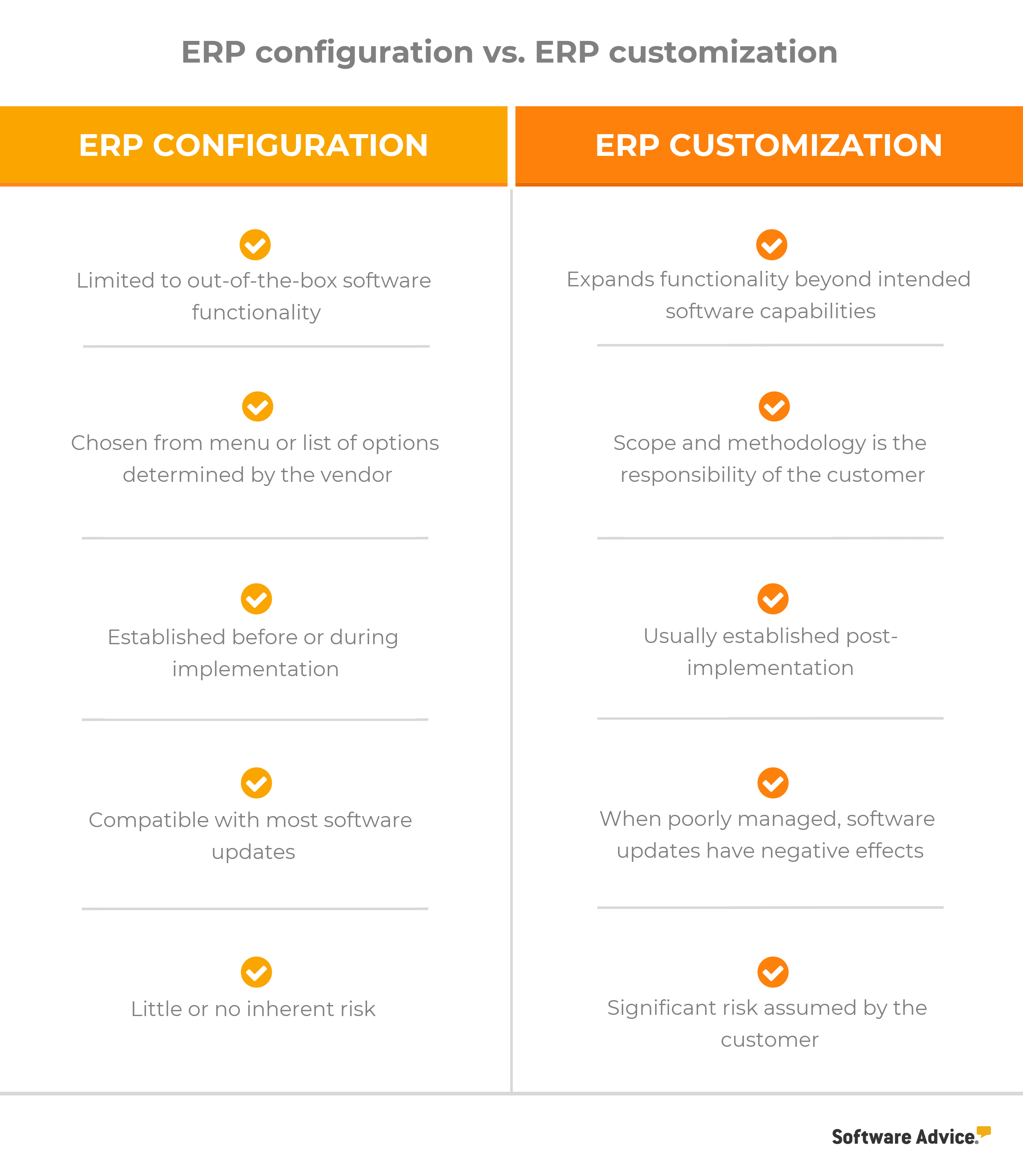How to Manage ERP Customization—in 4 Simple Steps
Without differentiation, you have no competitive edge. In today’s increasingly saturated and rapidly evolving landscape, businesses that fail to separate themselves are destined to get lost in the shuffle.
Exhibit A: the ERP software market, where postmodern deployment options and ERP customization have become integral to the success of forward-thinking businesses across all industries. While there’s no shortage of ERP solutions to choose from, you’re unlikely to find the system of your dreams—at least not right out of the box.
But haphazardly managed customizations jeopardize an ERP’s long-term viability, making it incompatible with new software updates and outdating an otherwise perfectly functional system. This, unfortunately, has caused many businesses to simply avoid ERP customization altogether—differentiation be damned.
The solution? A lot of planning—and a little bit of gumption.
 By wisely selecting and carefully managing ERP customization, businesses will mitigate risk while extending the long-term viability of their investment.
By wisely selecting and carefully managing ERP customization, businesses will mitigate risk while extending the long-term viability of their investment.
Here’s what businesses need to do:
1. Understand the different types of ERP customizations
2. Use modern, robust technologies with built-in abstraction layers
3. Assess the customization’s long-term business value
4. Declutter the ERP system by retiring unnecessary customizations
1. Understand the different types of ERP customizations
ERP customizations are many things, but they’re not configurations. The difference is subtle yet significant.
Configurations are tweaks made to the default settings in your out-of-the-box ERP software—things like access control, custom fields, and preferred units of measurement. Such changes are usually chosen prior to implementation, from a preset list or menu of options, and require no alterations to an ERP’s underlying architecture.

On the other hand, ERP customizations have a much broader purview, and typically involve extensive coding modifications. They’re far more labor intensive, and the margin for error is virtually nonexistent. Done right, however, the benefits are plentiful.
Types of customizations include (but are not limited to) things like:
User interface: Cosmetic and design changes based on user preferences.
Documents and forms: The layout, format, and content of order confirmations, invoices, delivery notes, etc.
Integrations: Third-party software designed to supplement the core ERP system.
Functionality modifications and extensions: Changing the system’s source code to add new features or enhance existing functionality.
A word to the wise: Use customizations cautiously and sparingly. The more you create, the more complex your system becomes—and the harder it’ll be to install critical software updates from the vendor.
2. Use modern technologies with built-in abstraction layers
Poorly managed customizations have long-lasting consequences on your system, inhibiting your ability to install future upgrades and rendering it incompatible with critical vendor updates (which, in cloud-based systems, install automatically).
When a customer’s code modifications coincide with a vendor’s, the collision is often disastrous—like watching a train derail in slow motion.
Enter: abstraction layers.
An abstraction layer, at its essence, is a sort of customization laboratory. It’s an extra interface or parameter within the application that separates your ERP customizations from the rest of the underlying code, thereby shielding them from vendor updates. By separating the two, businesses can test a customization’s compatibility and tweak it without damaging the system as a whole.
Most modern ERPs have built-in abstraction layers. If yours doesn’t, or if its layers are insufficient, consult with your vendor to determine the best way to integrate them into your system. It won’t be cheap, but it’ll save money in the long run.
3. Manage customizations to ensure long-term business value
ERP software is vital to the success of your business, and protecting the longevity of your investment is paramount.
To do so, begin by identifying customizations that address business needs and provide demonstrated value to the organization. Businesses that only assess the short-term gains—and not long-term viability—will be left licking their wounds.
Say it with me: All proposed customizations should be scrutinized and justified with empirical data.
When evaluating the long-term value of a customization, ask questions like:
What business challenge does this customization address?
How much value is added by customization? How was the value calculated?
Is there any scenario in which this customization would be unnecessary?
Can it be built in a way that isn’t intrusive to the software’s architecture?
What resources and budget are required to sustain its business value?
No question is too rigorous, no detail too meticulous. All of it matters.
Once an ERP customization is complete, ongoing source code management and documentation of customization-related activities are necessary to preserve the integrity of your ERP system. If your business isn’t prepared to put in the work, perhaps ERP customizations aren’t in your future.
4. Declutter your ERP system by retiring unnecessary customizations
There’s one constant in the business world: change. Your organization’s needs and objectives aren’t the same as they were a year ago, much less five years ago, and what was once a necessary initiative might not be so necessary today.
In other words, if an existing ERP customization no longer increases business value, there’s no point in keeping it.
As Gartner explains, “A ‘clean’ system uncluttered by modifications and enhancements that are no longer urgently needed is easier and more cost-effective to manage.” (Full content available to clients.)
Every unnecessary line of code puts additional burden on your system, draining valuable resources and needlessly complicating its structural design.
After identifying a dispensable customization, you can retire it in one of three ways:
Removing it entirely. Think of your ERP system as a human body, and the customization as a tumor. The more isolated a customization, the less likely its removal will adversely impact the rest of the system. Only remove a customization if you’re certain the rest of the ERP can subsist without it.
Disabling and hiding the functionality in the system. When a customization is distributed among multiple system components, its removal will likely affect everything it touches (and not in a good way). In such a scenario, it’s better to simply disable or hide the customization and leave the underlying code as intact as possible.
Deciding not to upgrade your system or rebuild the customization in the new version. This should be your last resort, a scenario to be considered only when disabling or removing a customization would effectively kill your system. You’ll miss out on security updates and functionality enhancements, but hey, at least you’ll still have an ERP.
Again, your chosen method of retirement will depend on the nature of the customization, its relationship with the software, and the ease with which you can modify it. Just remember: The more entwined it is, the more caution you should exercise.
Next steps
ERP customization will never be a cakewalk, but don’t let that dissuade you. Hopefully the recommendations above serve as words of encouragement—that doing it right is not only possible, but essential for the long-term success of your business.
If you’re intrigued by customization but need a nudge in the right direction, here are some things you can do right now to get started:
Identify your desired functionality. The ERP software market is always evolving. But with new challenges comes a new array of solutions, the bulk of which can be assessed in our database of more than 160 ERP vendors. Comparing your existing functionality with those of other software options will give you an idea of what you can achieve through customization.
Consult with your vendor. Before making any significant changes to your ERP, it’s important to discuss any potential ramifications with your current vendor. They know the software better than anyone, and can offer guidance on how to minimize disruptions that come as a result of customization.
Give us a call. It’s possible that, upon closer examination, you’ve determined that your ERP system simply isn’t a good fit for customization. Worry not: Our expert advisors are at the helm, ready to offer multiple solutions to obtain your business objectives. For a free, no-obligation phone consultation, call (855) 998-8505.